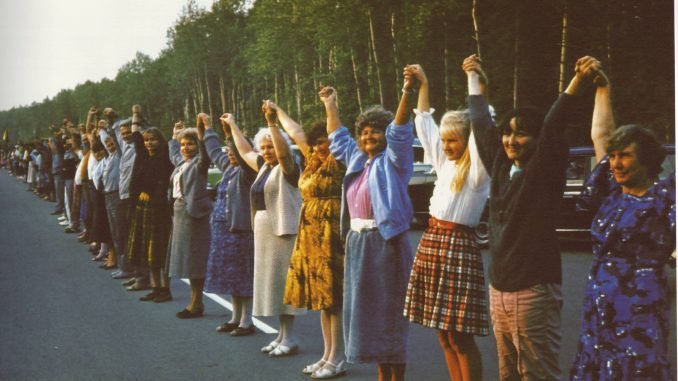
The Baltic Way greatly adjusted my, a then Sąjūdis Seimas council member and council secretariat official, forecasts. I had no doubt that the event, which was already being considered from early 1989, would succeed, but I imagined a far more humble scale, Mečys Laurinkus wrote in lrytas.lt
I thought that the Kremlin, factually M. Gorbachev’s hand, would slam their fist on the able – enough. Not only threatening with implementing martial law, but also in part demonstrating it, leading to Lithuanian residents considering consequences prior to joining the living chain.
Back then, it was natural to not dismiss the bad scenarios, this did not mean cowering in fear, but quite the contrary, it was proof of a feeling that you are responsible not just for yourself, but also the consequences for all of Lithuania’s people.
By the way, namely, under conditions of potential bad consequences being discussed, an appeal emerged from a number of Sąjūdis Seimas Council members (including me) to the Lithuanian public – “what if” if the “Kremlin’s paw” re-emerged, how to act?
This is in part what was said in the appeal: “do not yield to incitement for chaotic rebellion…”, “do not report…”, “do not fall spiritually and abuse alcohol…”, “do not read or subscribe to government newspapers…”, “do not participate in any elections…”, “do not abandon Lithuania and do not agree for our youth to be taken away.”
Honestly, I mused many times, how we should act if the soviets repeated the scenarios of Hungary, the Czech Republic and Poland?
Into the forests? With my family? Up to the signing of the fairly odd “document”, at least I would not ponder such questions. Somehow, I was convinced that the Soviet government would not disperse the Sąjūdis and that there would be no repressions.
But on January 13, in the face of a threat, the musings became much more concrete – remain in office, also in the Seimas Palace, opposing with available measures all the way to the end.
This does not mean that there was no worry and fear. We now all know how the Baltic Way ended and January 13 is now a celebration of victory.
There is much archival material, many testimonies, tales, photographs, various chronicles, thus even if you try, you can’t appear to know more than others.
I am often asked, who got the idea of the Baltic Way first. A few years ago, I visited Estonia. During lunch with the famous E. Savisaar, I heard (from his circle) that the genius, eternally historical idea is his. I did not dispute this (during lunch?).
In my belief, it is worth seeking, who was the first to propose such an idea is worth simply out of curiosity. The Baltic Way is a product of Estonia, Latvia and Lithuania’s struggle for freedom. “Copyrighted” by the three countries. Furthermore, it can’t ever be repeated. The fundamental component of the Baltic Way was a feeling of unity. How do you recreate it?
The idea of the Baltic Way itself, with various primary variants, was very well described in V. Čepaitis’ book Su Sąjūdžiu už Lietuvą. V. Čepaitis was the Sąjūdis’ representative in the three-country group when realising the event.
By the way, the Baltic Way has its own folklore. While witnesses are still alive, students could be gathered during summers. What is the meaning of the Baltic Way?
Much has been written about it and correctly, it isn’t even worth repeating. I want to only say what I feel is important.
The Baltic Way was the final recognition that after the large protest in Vingis Park, the Sąjūdis Congress that the policy of the Sąjūdis, as well as the movements in Estonia and Latvia, is correct. Such clear universal support was needed for both the Sąjūdis and for colleagues in Estonia and Latvia.
There were protests before as well, but sometimes the question would arise if the movement isn’t contained in a bubble of its own.
It is no secret – not all of the Sąjūdis Seimas Council sittings were smooth sailing. The much earlier announced Sąjūdis Seimas Moral Unity Declaration was not born of good circumstances. There would even be disputes on minor details. Not to even speak of personal sympathies and antipathies.
After the Baltic Way, strategic questions returned to the council, the communication atmosphere improved manifold. The impressive background of the Baltic Way simply pushed to speak and act responsibly.
Organising other events, signature collection went better as well. The “moving” of the soviet army also seemed less threatening.
Another important topic that is important to these days is the capacity to unite at the final moment. Political life in Lithuania, which had been united by the Sąjūdis, began to fall apart and disperse into mutually conflicting larger and smaller groups well before the snap elections in 1992.
The time of the Baltic Way gradually faded into history, until all that was left was a romantic episode of public and political life.
Finally, there no longer was a pretext to demonstrate anything similar. The big questions of the state rapidly mixed with mundane ones, generating ever more pointless disputes. With minor exceptions (accession to the EU and NATO), this continues to these days.
If the X hour came, would Lithuania manage to unite as it had in the Baltic Way? For now, even if without exceptional certainty, I could say yes.
Lithuania is dispersing not only physically, but also in terms of thoughts and emotions regarding emotions toward the state. And how much of the spirit of the Baltic Way is there left between the three Baltic States?
In the extreme case of a war against a mutual enemy, without a doubt, we would stand alongside one another. But in all other cases, even very important ones, it would be each to their own.
The pleasantries of the Lithuanian-Latvian presidential meeting hadn’t yet cooled, including Riga’s promise to delve into our concerns over Astravyets, but our strategic neighbour already declared it would buy electrical power from the new Belarussian nuclear power plant.
Estonia has its own, certainly not the same as Lithuania, opinion about relations with Russia.
The Baltic Way emerged from the Baltic Assembly. I guess that many no longer even recall the name of such an institution. We will mark the days of the Baltic Way well.
Are they still meaningful for the future?


Be the first to comment